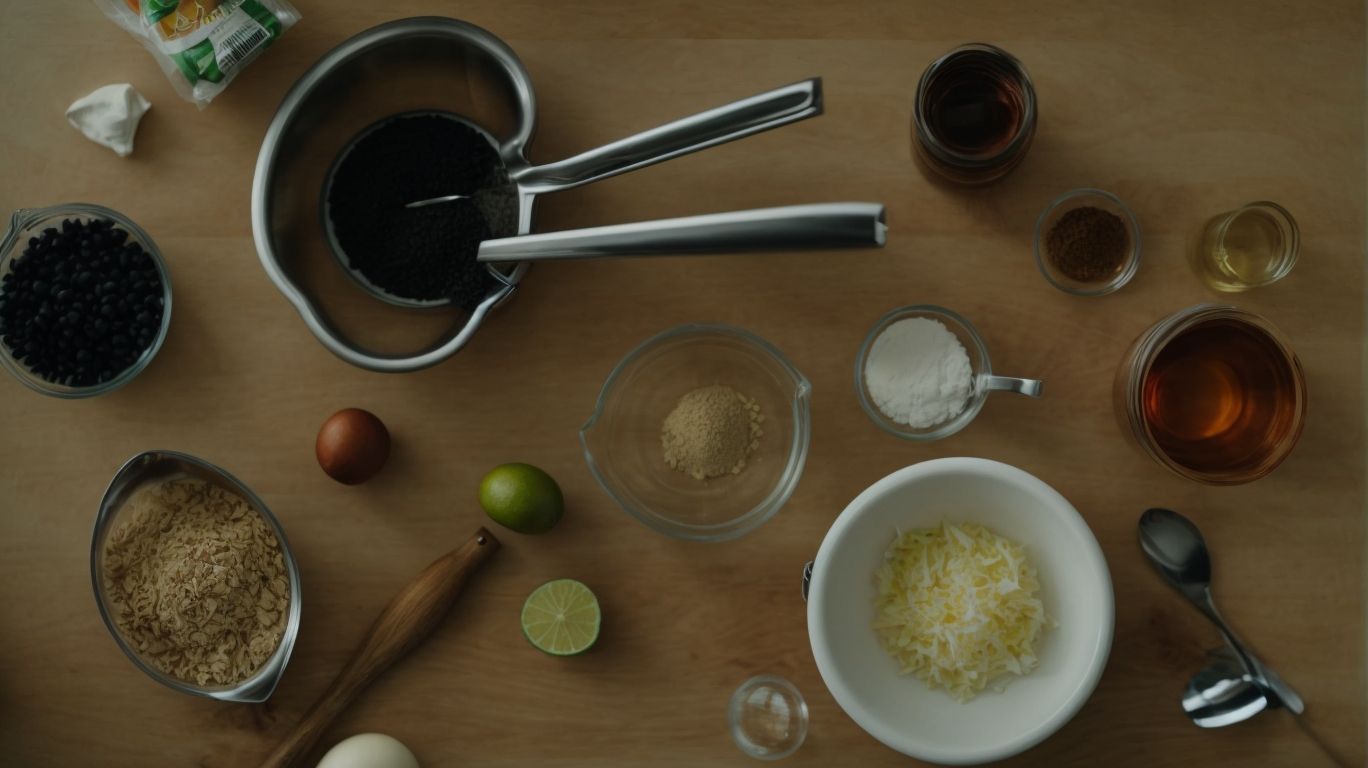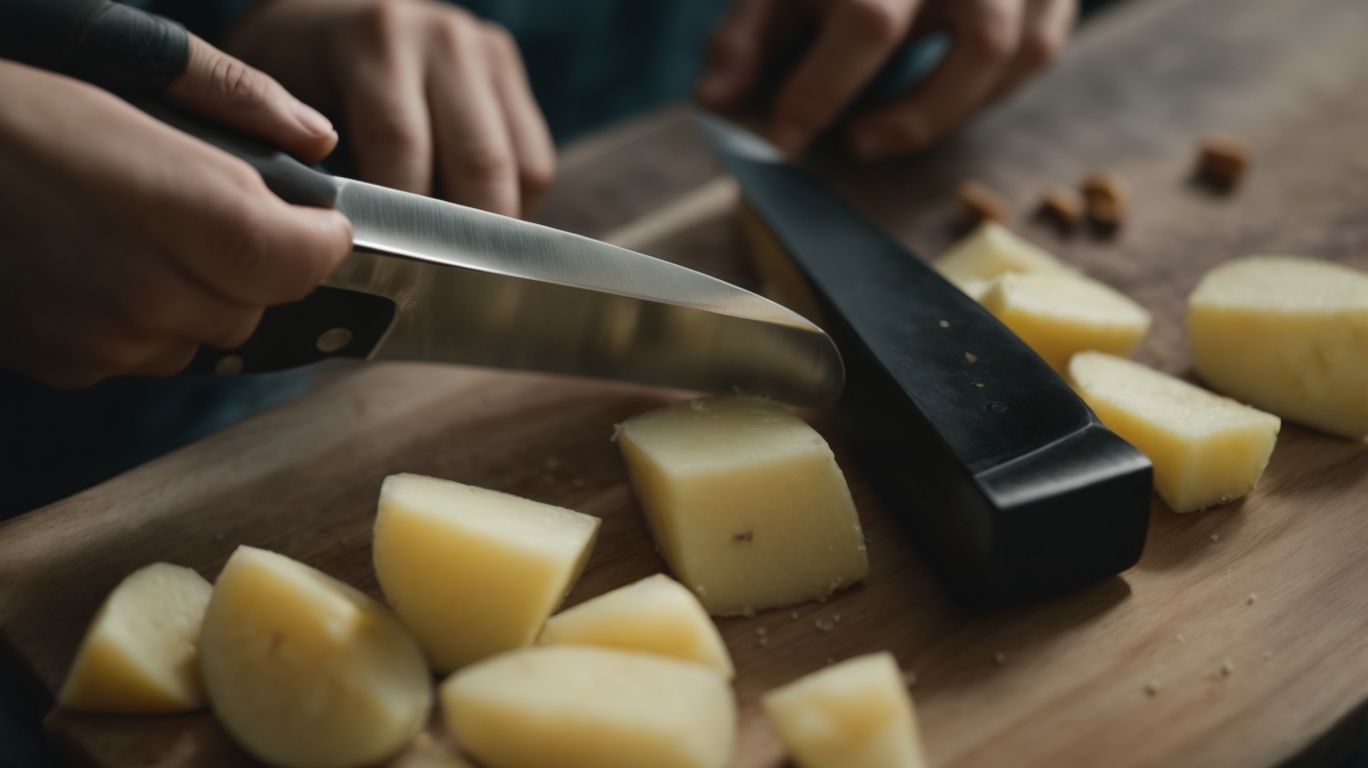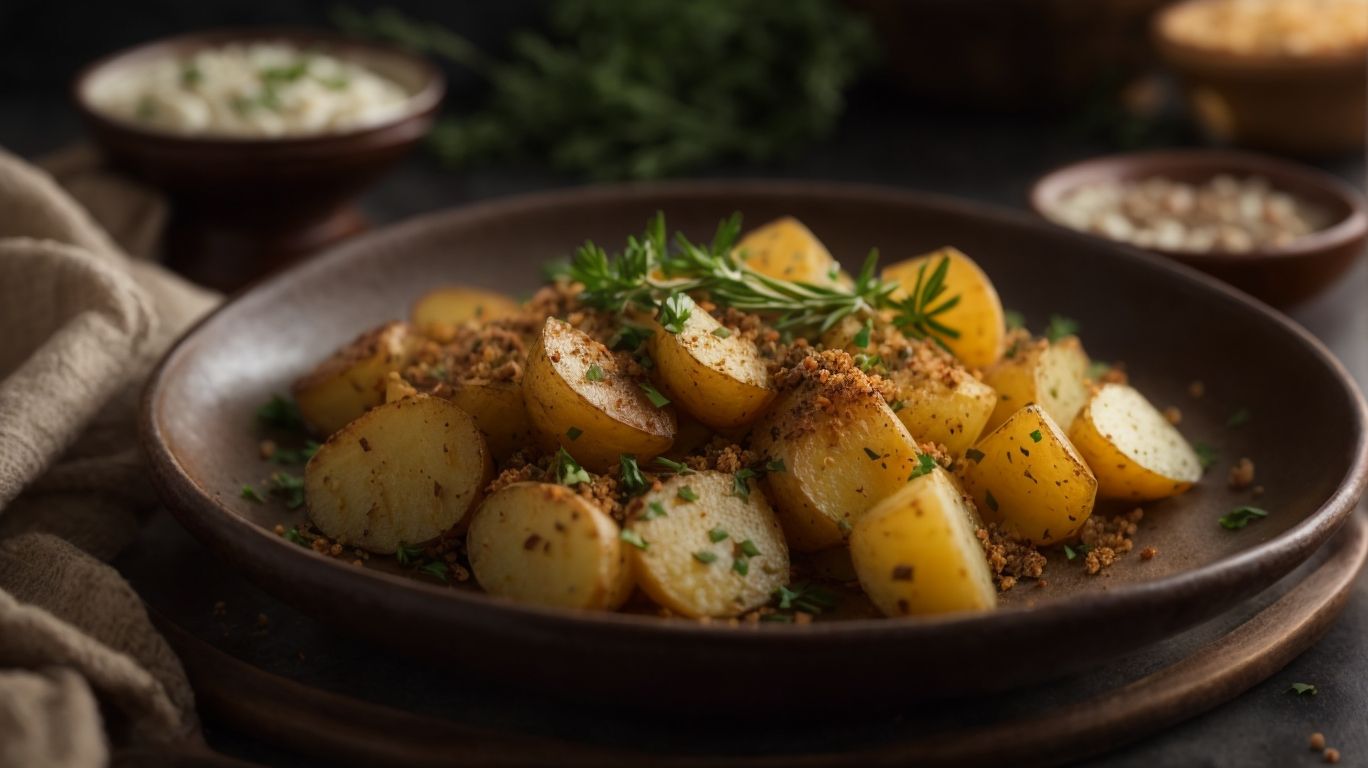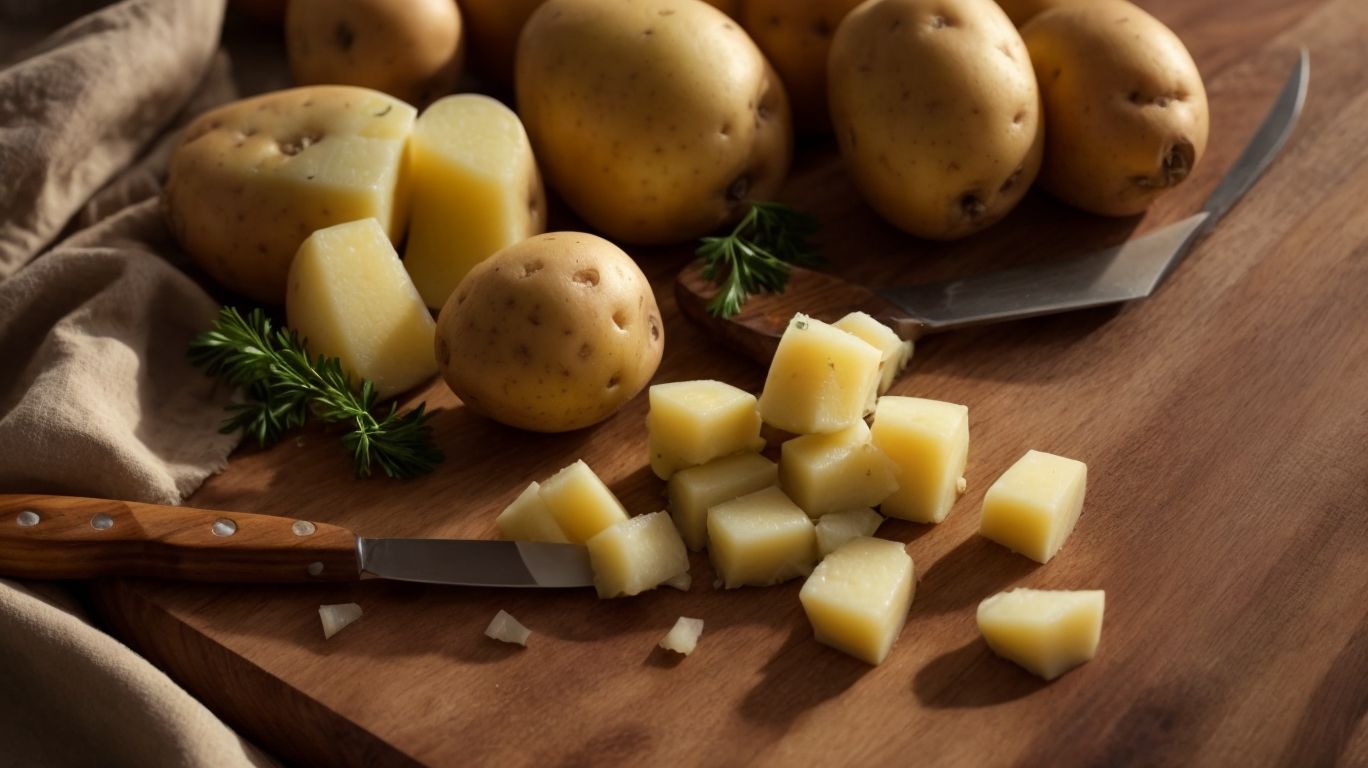How to Bake Diced Potatoes?
Looking to elevate your side dish game? This article will guide you through baking diced potatoes to perfection. From selecting the right potatoes to adding flavorful ingredients, dicing and preparing the potatoes, to baking tips and serving suggestions – we have you covered. Whether you’re a beginner or an experienced cook, these tips and tricks will assist you in creating irresistibly delicious baked diced potatoes consistently.
Key Takeaways:
What You’ll Need to Bake Diced Potatoes

Credits: Poormet.Com – Samuel Williams
To bake diced potatoes, you’ll need a few essential ingredients and tools to achieve that perfect balance of crispy and fluffy textures.
First and foremost, gather fresh diced potatoes, olive oil, salt, black pepper, garlic powder, and a selection of herbs like rosemary or thyme to season the dish. Ensure you have a baking sheet, parchment paper, a sharp knife for dicing the potatoes, and a mixing bowl for tossing them with the seasonings and oil.
What Type of Potatoes Should You Use?
When making diced potatoes, selecting the right type of potatoes is crucial to achieving the desired texture and flavor.
Baking diced potatoes is a versatile dish that can be enjoyed in numerous ways, from crispy roasted sides to savory accompaniments for main courses. Russet potatoes are a popular choice due to their high starch content, resulting in a fluffy interior and crispy exterior when baked. On the other hand, Yukon Gold potatoes offer a buttery texture and slightly sweet flavor, perfect for adding richness to the dish.
If you’re looking to shake things up, consider using sweet potatoes for a twist on the classic. Their natural sweetness caramelizes beautifully when baked, adding a unique flavor profile to the dish.
What Other Ingredients Can You Add?
Along with potatoes, you can enhance the flavor of your baked diced potatoes by incorporating ingredients like garlic powder, fresh herbs, and a drizzle of olive oil.
Garlic powder adds a wonderful depth of savory flavor to the potatoes, infusing them with a fragrant aroma during baking. Fresh herbs, such as rosemary, thyme, or parsley, bring a burst of freshness and earthiness that complements the potatoes beautifully. A generous drizzle of olive oil not only helps in achieving a crispy exterior but also imparts richness and a hint of fruitiness to the dish, elevating its overall taste and texture.
Preparing the Potatoes for Baking

Credits: Poormet.Com – Tyler Jackson
Before baking diced potatoes, proper preparation is essential, including washing, peeling, and dicing the chosen potatoes to ensure even cooking and optimal texture.
In terms of russet potatoes, it’s crucial to wash them thoroughly to remove any dirt or debris from the skin. Peel the thick skin adequately, ensuring to remove any green spots or eyes, and then proceed to dice them into uniform pieces to promote consistent cooking.
On the other hand, Yukon gold potatoes have a more delicate skin, so gentle washing is essential to avoid damaging the thin outer layer before peeling. Dicing them into slightly larger chunks preserves their buttery texture.
Sweet potatoes require careful washing to remove any dirt, as their skin is edible, but peeling is still recommended if preferred. Dice them into chunks to prevent them from becoming too mushy when baked.
How to Dice the Potatoes?
When dicing potatoes for baking, it’s essential to cut them into uniform pieces to ensure even cooking and consistent texture throughout the dish.
Start by selecting firm and fresh potatoes with smooth skins to achieve the best results in your baking.
- After washing and peeling the potatoes, place them on a cutting board and carefully slice them into long vertical strips.
- Then, align the strips and chop them horizontally into pieces of the desired size, aiming for uniformity to avoid uneven cooking.
Remember, the key to perfectly diced potatoes lies in maintaining a consistent size and shape for each piece, ensuring they bake evenly in the oven.
Should You Peel the Potatoes?
Whether to peel the potatoes before baking largely depends on personal preference and the type of potato used, such as russet or Yukon gold, with considerations for texture and presentation.
For russet potatoes, leaving the skin on can result in a crispier texture and a more rustic appearance, as the skin helps to hold in moisture during baking. Peeling russet potatoes may result in a creamier consistency and a slightly milder flavor due to the removal of the skin, which can sometimes be tough.
On the other hand, Yukon gold potatoes have a naturally thin and tender skin that becomes deliciously crispy when baked, hence many prefer to leave the skin on for added texture and flavor. Nonetheless, peeling Yukon gold potatoes can yield a smoother and more uniform appearance, ideal for dishes requiring a more refined presentation.
Baking the Diced Potatoes
Once the diced potatoes are prepped, the next step is to bake them to perfection, ensuring a balance of crispy exteriors and fluffy interiors by following precise temperature and timing guidelines.
Baking diced potatoes to achieve that ideal texture requires attention to detail. Preheat your oven to around 425°F (220°C) for that perfect balance of crispy edges while keeping the insides nice and soft. Spread the diced potatoes evenly on a baking sheet to ensure they cook uniformly.
Remember not to overcrowd the baking sheet, allowing enough room for air circulation. This is key to getting those crispy bits without sacrificing the fluffiness inside. Check the potatoes halfway through baking and give them a gentle toss for even browning.
What Temperature Should the Oven Be?
To bake diced potatoes to crispy perfection, preheat the oven to a high temperature to promote browning and ensure a delightful crunch in every bite.
When subjected to high heat, the exterior of the diced potatoes quickly forms a crispy crust, creating a contrast with the soft interior. This high-temperature method is ideal for achieving that sought-after crispy texture without drying out the potatoes.
Keep in mind that the key to successful crispy potatoes lies in the initial blast of heat which locks in moisture while allowing the outside to crisp up. This results in a dish that is not only visually appealing with its golden color but also offers a satisfying crunch that enhances the overall taste experience.
How Long Should You Bake the Potatoes?
The baking duration for diced potatoes depends on the size of the cuts and desired level of crispiness and fluffiness, typically ranging from 20-30 minutes for perfect results.
When baking diced potatoes, it’s important to take into account their thickness as this greatly impacts the cooking time. For smaller 1/2-inch cubes, a shorter baking time of around 20 minutes at 400°F will yield a crispy exterior with a soft, fluffy interior. If you prefer a more tender and slightly crisp texture, opt for 30 minutes in the oven. Larger 1-inch cubes may require an additional 5-10 minutes in the oven to achieve that perfect balance of crispy edges and velvety insides.
Should You Use a Baking Sheet or a Baking Dish?
When baking diced potatoes, the choice between a baking sheet and a baking dish can impact the final texture, with baking sheets promoting crispiness and baking dishes retaining moisture for fluffier results.
Baking sheets are typically flat and allow for better air circulation around the diced potatoes, resulting in a more uniform crispiness. This is ideal for achieving a golden brown exterior with a satisfying crunch when you bite into the potatoes.
On the other hand, baking dishes, with their deeper sides, trap moisture within, helping the potatoes retain their natural juiciness and providing a softer, more tender texture.
Depending on your preferences, you can choose between a baking sheet for a crispy finish or a baking dish for a softer, moister outcome. If you enjoy the contrast between a crunchy outside and a fluffy inside, opt for a baking sheet. Conversely, if you prefer your diced potatoes to be tender and succulent throughout, using a baking dish may be the way to go.
Tips for Perfectly Baked Diced Potatoes
Achieving perfectly baked diced potatoes involves mastering a few key tips, such as ensuring crispiness, preventing sticking, and expertly seasoning the dish for maximum flavor.
To enhance the crispiness of the diced potatoes, make sure to pat them dry thoroughly before seasoning. This helps in removing excess moisture, allowing the potatoes to crisp up nicely in the oven. Additionally, preheating the baking sheet in the oven before adding the diced potatoes can help create a crispy exterior. To prevent sticking, consider lining the baking sheet with parchment paper or generously greasing it with oil. It is essential to evenly space out the diced potatoes to ensure they cook uniformly and don’t stick together.
How to Get Crispy Potatoes?
To achieve crispy diced potatoes, consider using cooking methods like baking in the oven or utilizing an air fryer for a crunchy exterior and a fluffy interior.
When baking diced potatoes in the oven, preheat the oven to a high temperature, around 425°F (218°C), to kickstart the crisping process. Toss the diced potatoes in a light coating of oil, season with your favorite spices, and spread them out on a baking sheet in a single layer for even cooking. Avoid overcrowding the pan to ensure proper airflow and prevent steaming. Roast them until they turn golden brown and crispy on the outside, while maintaining a soft and tender inside.
How to Prevent the Potatoes from Sticking to the Pan?
To prevent diced potatoes from sticking to the pan during baking, consider using a light coating of oil or parchment paper, especially when using a frying pan for added convenience.
Another effective method to avoid sticking is to preheat the pan before adding the diced potatoes. This initial heat treatment forms a barrier between the pan surface and the potatoes, reducing the chances of sticking. You can sprinkle a thin layer of cornstarch or flour on the diced potatoes before placing them in the pan; this helps absorb excess moisture and provides a protective layer. Using a well-seasoned cast-iron pan can also prevent sticking due to its natural non-stick properties.
How to Season the Potatoes?
Seasoning diced potatoes offers a creative outlet for enhancing flavor profiles, with options ranging from herbs and garlic powder to specialized seasonings that complement the dish.
Herbs are a classic choice when it comes to seasoning diced potatoes. Basil, thyme, rosemary, or a blend of Italian herbs can add a fragrant and earthy dimension to the dish. Ginger and garlic powder can bring a warm and robust flavor that can transform simple potatoes into a flavorful delight. Experimenting with flavor enhancers like smoked paprika, cumin, or chili powder can provide a unique twist that elevates the overall taste experience. Mixing and matching these seasonings can result in a rich and diverse flavor profile, enhancing the final dish in unexpected ways.
Serving Suggestions for Baked Diced Potatoes

Credits: Poormet.Com – Raymond Rivera
Once baked to perfection, diced potatoes offer versatile serving options and pair well with a variety of dishes, making them an excellent side dish or standalone option.
For serving suggestions, consider topping the baked diced potatoes with sour cream, chives, and crispy bacon bits for a loaded potato experience. Alternatively, mix them with sautéed peppers and onions for a Southwestern twist. For pairings, they complement grilled meats such as steak or chicken brilliantly.
In terms of leftovers, don’t overlook the potential for creativity. Use them as a base for a breakfast hash with eggs and cheese or incorporate them into a hearty potato salad with a tangy dressing. Their versatility allows you to incorporate them into various dishes, from soups to casseroles.
What Dishes Pair Well with Baked Diced Potatoes?
Pairing baked diced potatoes with dishes like roasted chicken or steak creates a harmonious balance of flavors and textures, offering a satisfying meal experience.
For those looking to elevate their culinary experience, consider adding a side of grilled asparagus or sautéed green beans to complement the hearty flavors of the potatoes. The freshness and crunch of the asparagus or green beans can provide a nice contrast to the softness of the baked potatoes, creating a well-rounded meal.
To add a touch of sophistication to your dinner, a side of creamy mushroom risotto or a tangy arugula salad can be wonderful accompaniments. The earthy umami flavors of the mushrooms in the risotto perfectly complement the simplicity of the potatoes, while the peppery arugula salad adds a refreshing kick to each bite.
How to Store Leftover Baked Diced Potatoes?
When dealing with leftover baked diced potatoes, store them in airtight containers or freezer bags to maintain freshness and extend their shelf life for future use.
Proper storage is crucial to prevent the potatoes from spoiling quickly. Make sure to allow the potatoes to cool completely before transferring them to the containers. Label each container with the date to keep track of freshness. If using freezer bags, remove excess air before sealing to prevent freezer burn.
Place the containers or bags in the refrigerator or freezer, depending on when you plan to use them. Frozen diced potatoes can last for several months, while refrigerated ones are best consumed within a week. Remember to thaw frozen potatoes in the refrigerator before reheating.
Frequently Asked Questions
How to Bake Diced Potatoes?
1. What ingredients do I need to bake diced potatoes?
To bake diced potatoes, you will need potatoes, olive oil, salt, and any additional seasonings or herbs of your choice.
2. Should I peel the potatoes before dicing them?
It is completely up to personal preference whether or not to peel the potatoes. The skin adds extra nutrients and texture, but if you prefer a smoother texture, you can peel them before dicing.
3. How should I dice the potatoes?
You can dice the potatoes into small cubes or larger chunks, depending on your preference. Just make sure they are all similar in size so they cook evenly.
4. What is the best oven temperature for baking diced potatoes?
The ideal temperature for baking diced potatoes is 400°F (200°C). This allows them to cook evenly and develop a crispy exterior.
5. How long should I bake diced potatoes for?
On average, diced potatoes take about 25-30 minutes to bake at 400°F (200°C). However, the exact cooking time may vary depending on the size of the potato cubes and your desired level of crispiness.
6. Can I add other ingredients to my baked diced potatoes?
Yes, you can add other ingredients such as diced onions, bell peppers, or garlic to your baked diced potatoes for added flavor. Just make sure they are diced to a similar size as the potatoes so they cook evenly.

